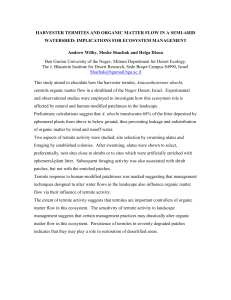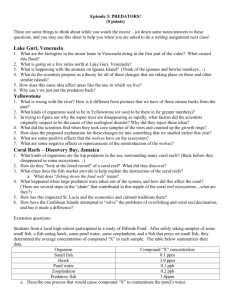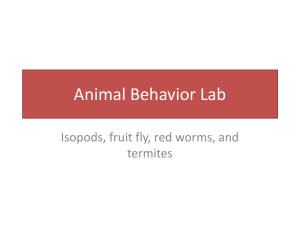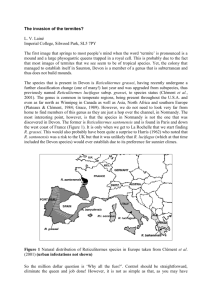Bohart Museum Society
advertisement
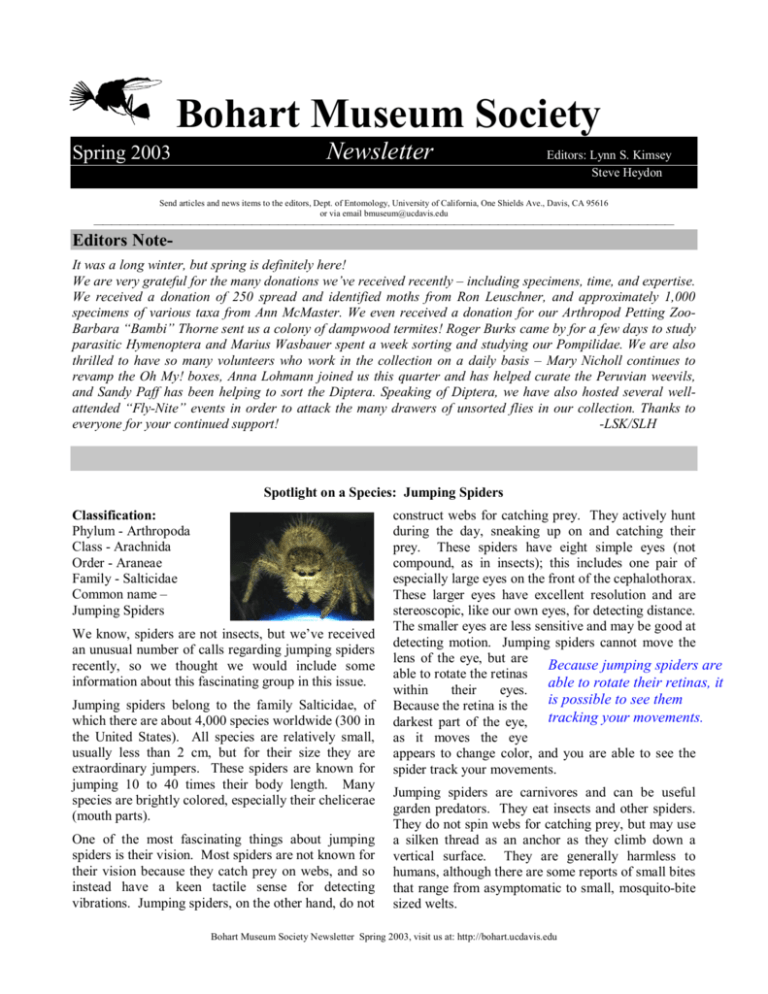
Bohart Museum Society Spring 2003 Newsletter Editors: Lynn S. Kimsey Steve Heydon Send articles and news items to the editors, Dept. of Entomology, University of California, One Shields Ave., Davis, CA 95616 or via email bmuseum@ucdavis.edu Editors NoteIt was a long winter, but spring is definitely here! We are very grateful for the many donations we’ve received recently – including specimens, time, and expertise. We received a donation of 250 spread and identified moths from Ron Leuschner, and approximately 1,000 specimens of various taxa from Ann McMaster. We even received a donation for our Arthropod Petting ZooBarbara “Bambi” Thorne sent us a colony of dampwood termites! Roger Burks came by for a few days to study parasitic Hymenoptera and Marius Wasbauer spent a week sorting and studying our Pompilidae. We are also thrilled to have so many volunteers who work in the collection on a daily basis – Mary Nicholl continues to revamp the Oh My! boxes, Anna Lohmann joined us this quarter and has helped curate the Peruvian weevils, and Sandy Paff has been helping to sort the Diptera. Speaking of Diptera, we have also hosted several wellattended “Fly-Nite” events in order to attack the many drawers of unsorted flies in our collection. Thanks to everyone for your continued support! -LSK/SLH Spotlight on a Species: Jumping Spiders Classification: Phylum - Arthropoda Class - Arachnida Order - Araneae Family - Salticidae Common name – Jumping Spiders We know, spiders are not insects, but we’ve received an unusual number of calls regarding jumping spiders recently, so we thought we would include some information about this fascinating group in this issue. Jumping spiders belong to the family Salticidae, of which there are about 4,000 species worldwide (300 in the United States). All species are relatively small, usually less than 2 cm, but for their size they are extraordinary jumpers. These spiders are known for jumping 10 to 40 times their body length. Many species are brightly colored, especially their chelicerae (mouth parts). One of the most fascinating things about jumping spiders is their vision. Most spiders are not known for their vision because they catch prey on webs, and so instead have a keen tactile sense for detecting vibrations. Jumping spiders, on the other hand, do not construct webs for catching prey. They actively hunt during the day, sneaking up on and catching their prey. These spiders have eight simple eyes (not compound, as in insects); this includes one pair of especially large eyes on the front of the cephalothorax. These larger eyes have excellent resolution and are stereoscopic, like our own eyes, for detecting distance. The smaller eyes are less sensitive and may be good at detecting motion. Jumping spiders cannot move the lens of the eye, but are Because jumping spiders are able to rotate the retinas able to rotate their retinas, it within their eyes. Because the retina is the is possible to see them darkest part of the eye, tracking your movements. as it moves the eye appears to change color, and you are able to see the spider track your movements. Jumping spiders are carnivores and can be useful garden predators. They eat insects and other spiders. They do not spin webs for catching prey, but may use a silken thread as an anchor as they climb down a vertical surface. They are generally harmless to humans, although there are some reports of small bites that range from asymptomatic to small, mosquito-bite sized welts. Bohart Museum Society Newsletter Spring 2003, visit us at: http://bohart.ucdavis.edu Pest Notes Termites Ecologically, termites play an important role in the world as recyclers of dead and decaying wood. However, they are also destructive pests of building materials and cost around $1 billion each year in the U.S. for treatment and repairs. There are at least 45 species of termites in this country – not all of them native – and 30 of these are considered pests. Most termites can be broadly classified as either drywood or subterranean. Drywood termites nest and spend most of their lifecycle within wood. Subterranean termites live and Figure 1 Termite worker, soldier nest in the ground, and and alate (reproductive). From forage above ground. Gullan and Cranston. 2000. The In general, subterranean Insects: An Outline of Entomology. Blackwell Science. termites cause more damage to homes and other structures than drywood termites because their colonies can get much larger (some termite colonies can have as many as 7 million foragers). A colony or nest of subterranean termites may be up to 18-20 feet below the soil surface to protect it from extreme weather conditions. The most economically important subterranean termite in California is Recticulitermes flavipes. An even more destructive termite, the Formosan termite Cryptotermes formosanus has been getting a lot of attention lately, but it has only been established in the southern states. Termites start life as eggs, which hatch into small larvae. The larvae develop through 6 or 7 stages, with each stage lasting from 2 weeks to 2 months. Termites are relatively long-lived for insects, with average life spans of 3 to 5 The most economically important years. A mature termite in the California is termite colony has western subterranean termite, reproductives Recticulitermes flavipes. (king and queen), soldiers, and workers. Full-grown workers are soft-bodied, wingless, blind and creamy white. Soldiers also have light-colored bodies, but their heads and mandibles are usually dark brown or black. Termite colonies have both a queen and a king. As young adults, queens and kings have wings, but once the colony is established they will shed their wings. If a queen or king dies, a particular type of worker may become a replacement queen or king. Control of Termites Suppressing termite activity in or around one’s home is not an easy task. Because they live in large numbers deep underground it is difficult to eradicate an entire colony. Baits. Some products act as baits, to attract termites to a slow-acting poison. This method can be effective because worker termites regurgitate digested food in order to feed soldiers and reproductives – this is called trophallaxis – and so the poisons can be Subterranean termites live in passed on from a few large numbers several meters workers to the entire underground, so it can be colony. The poison difficult to eradicate an entire must be slow acting colony. because termites will wall off contaminated food sources. Many pest control companies use perimeter baits that are placed in a ring or grid around the property. The percentage attack rate on perimeter baits are low (<10%), however once baits are found, feeding is persistent. Termite activity is seasonal, so it is best to bait termites when they are most active, especially in the late spring and early summer when they are producing reproductives. Foraging also wanes during very hot weather or persistent rains. Baiting takes 2 to 3 months before results are noticeable. One can make homemade baits by burying hollow wooden stakes, with the top end stuffed with cork or cardboard. Termite feeding can be monitored just by removing the stuffing and looking for evidence of Figure 2 A homemade termite bait. The corrugated cardboard in the PVC pipe is treated with a 0.1% Borax solution. Bohart Museum Society Newsletter Spring 2003, visit us at: http://bohart.ucdavis.edu termite damage. If termites are found, corrugated cardboard is inserted into the stake, leaving about an inch of the cardboard exposed above the stake. This cardboard, a favorite food of termites, will act to direct the termites up through the stake to the bait, which is placed at the top of the stake. The bait is made up of treated cardboard (cardboard soaked in a 0.1% boric acid solution) rolled into a short length of PVC pipe. This pipe is then capped (with a PVC cap) and placed on top of the stake. Chemical Treatments. Termites can also be controlled by chemical applications to soil around or under wooden structures, to the building materials themselves, or by fumigation. Chemical treatment of the soil for subterranean termites must be done wherever soil is in contact with wood. In some cases this means that treatment must be done beneath the foundation of a structure. It is also possible to purchase pre-treated lumber to prevent infestation. Fumigation is a treatment most often applied to drywood termites because the entire colony lives within the wood itself, not underground. Other Methods. There are other methods to control termites that are currently being researched. One of these is the release of a fungus that is a natural enemy of termites. Another is the use of a chemical that inhibits the production of cuticle by the termites, which prevents molting and growth. It may be that a combination of methods and careful monitoring to detect early infestations are the best means to control termites. Fun and Games Bohart Museum Society Newsletter Spring 2003, visit us at: http://bohart.ucdavis.edu Pest Notes Asian Woolly Hackberry Aphid The Asian Woolly Hackberry Aphid, Shivaphis celti Das, first appeared in the northern Central Valley last fall. The insect is a pest, not because of the damage it does to trees, but because it secretes copious amounts of a sticky honeydew that drips onto whatever is beneath them. This insect is recognizable by a fuzzy, bluish-white wax that covers the body. It is found on the underside of the leaves of hackberry (Celtis occidentalis, also called sugarberry), a commonly planted tree in the Central Valley because of its ability to withstand heat, drought, wind, and alkaline soils. This aphid is not a pest on other plants. Figure 3 Asian Wooly Hackberry Aphid winged adult. Photo courtesy of Univ. Florida Entomology Dept., P.M. Choate photographer. The Woolly Hackberry Aphid was first discovered in Florida in 1997, and has since spread rapidly across the south and into California. The aphid itself is quite small (2-2.5 mm long) but often appears larger because of the fuzzy wax covering. The antennae have a banded appearance, and the veins of the wings (when present) are slightly darkened. Figure 4 Asian Wooly Hackberry Aphid wingless adult. Photo courtesy of Univ. Florida Entomology Dept. P.M. Choate photographer. Like many aphid species, summer adults are all female and parthenogenic (able to produce more females asexually). Summer adults may be winged or wingless. In the autumn, winged males and wingless sexual females may be found, which will mate to produce an overwintering egg. This egg stage allows the aphids to survive the winter when there are no leaves on the trees. The sugary honeydew produced by the aphids often encourages the growth of a black mold. Everything under infested hackberry trees, such as cars, picnic tables, houses, and plants, may get a gooey coating of moldy honeydew. Luckily, because the honeydew is water soluble, a strong spray of water may be enough to rinse away the sticky substance. Spraying smaller trees with an insecticidal soap may serve double duty, by reducing the aphid population and cleaning the sticky surfaces. However, this control measure may have little effect on large infestations (involving many trees) or on a population on a large tree for which it is difficult to spray every leaf. Natural enemies (such as ladybugs and lacewings) may be most effective at reducing the aphid populations in the long run. Museum News… Explorit Science Center Meet the Scientist Day The Explorit Science Center on 5th Street in Davis hosted a “Meet the Scientist” Day on Saturday, May 17, 2003 in collaboration with the Bohart Entomology Museum. The event coincided with an ongoing exhibit at the Explorit during the month of April titled "What's the Buzz? Insects around Us." Sheryl SoucyLubell, our Outreach Coordinator, represented the Bohart Museum at the event. Visitors were able to view our collection of displays on insects of California, as well a few drawers of our more showy insects from around the world. Sheryl also brought along some of the most popular members of our Insect Petting Zoo including the Australian Spiny Walking Sticks, Death’s Head Cockroaches, Emperor Scorpion, Rose Haired Tarantula, and Californian termites. Children visiting the exhibit enjoyed taking away some of the coloring pages and activity sheets that we provided. The 2-hour meet-the-scientist event was free to visitors who paid admission the Explorit Science Center, and drew about 50 visitors. Bohart Museum Society Newsletter Spring 2003, visit us at: http://bohart.ucdavis.edu Nicaraguan Biodiversity Lynn S. Kimsey Steve’s trip to Nicaragua in March 2002 was so successful and interesting that we decided a follow up trip was needed. This time we took a variety of specialists from UCD to explore the countryside and discuss the possibilities of starting a nationwide biological inventory for Nicaragua. We brought along specialists in plant taxonomy (Ellen Dean), mammals and birds (Andy Engilis), insects (myself and Terry Sears) and yeasts (Kryia Boundy-Mills). Nicaragua is nearly unknown biologically, and decades of political strife and natural catastrophes, such as earthquakes and hurricanes, have destroyed national collections and much of the research and teaching facilities. The region appears to represent a biological boundary of sorts. Few plants and animals from South Figure 5 Terry Sears stands America disperse among the buttresses of a strangler fig. further north than Nicaragua. Conversely, few plants, animals or even migratory birds go further south. The actual barrier seems to be the Rio San Juan combined with Lake Nicaragua, which form the southeastern border between Nicaragua and Costa Rica. In Managua we met with Noël Pallais, Director General of the Insitututo Nicaragüense de Tecnologia Agropecuaria, and Telémaco Calavera, President of the Consejo Nacional de Universidades, to discuss the possibilities of building a Nicaraguan national biological inventory. Everyone we talked too was very enthusiastic. To begin the project As part of this project we would we are going to develop a biodiversity framework submit a grant for the country – to build national proposal to the US collections and begin training National Science taxonomic specialists. Foundation to inventory four sites in Nicaragua for three years. As part of this project we would develop a biodiversity framework for the country – to build national collections and begin training taxonomic specialists. Students, local villagers, and park biologists in Nicaragua would do most of the in-country work, including collecting, preparing specimens, and some taxonomy. We would train these individuals to sample insects using various collecting techniques such as hand netting, Malaise traps, pitfall traps and Winkler litter extractors. The Universidad Nacional Agraria will probably serve as the home base for this project. They have agreed to develop central facilities on the university campus for the study with our assistance, which would include preparation laboratories for whole animal and plant studies and a molecular biology lab for studies of DNA and microbes. This preliminary study would inventory the insects, plants, mamFigure 6 A strangler fig dubbed mals, birds, yeasts and the “transformer” tree in El lactobacteria in two Jaguar forest. sites in the coastal mountains (Volcan Mombacho National Park plus Zapatera National Park and San Juan del Sur) and two in the central cordillera (El Tigre Reserve near Jinotega and the mountains in Rio San Juan state, above the Costa Rican border). These habitats are coastal thorn scrub, cloud forest, coffee plantation, seasonal dry tropical forest and Caribbean wet forest. Bohart Museum Society Newsletter Spring 2003, visit us at: http://bohart.ucdavis.edu Bohart Museum Society Department of Entomology University of California One Shields Ave. Davis, CA 95616 29th Annual Fourth of July Butterfly Count Some local event locations and dates are: Friday, June 20: Berkeley, meet at north Oxford Tract Driveway off Walnut St. just north of Delaware St. Contact J. Powell (510-642-3207; powellj@nature.berkeley.edu) Saturday June 28: Yuba Pass, Sierra County. Contact Paul Opler (paulevi@webaccess.net) Saturday, June 7: Big Creek Reserve, Monterey County. Contact John Smiley (831-667-2543; jsmiley@ucsc.edu) Date TBA: Consumnes River Preserve, Sacramento County. Contact Kathy Schick (209-464-8304; ksachick@earthlink.net) For other butterfly counts and more information contact J. Powell (510-642-3207; powellj@nature.berkeley.edu) Also, check out this great website for butterfly checklists, distribution maps, and great photos of butterflies throughout the U.S.: http://www.npsc.nbs.gov/resource/distr/lepid/bflyusa/bflyusa.htm

